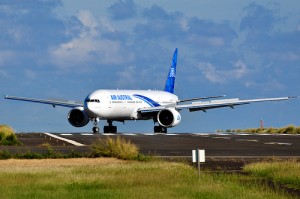
Air Austral Boeing 777-300 (F-OSYD) with a 3-class layout
Air Austral announced at the Dubai Airshow that they plan to buy two Airbus A380 superjumbo jets and configure them with all economy class, fitting about 840 passengers aboard. The airline is planning to fly the sardine-like-airplane between Reunion, France and Paris. They are the first airline to purchase the world’s largest airline in an all economy layout. Most airlines order A380’s in a multi-class seating of about 500 total seats.
Austral Air already has a fleet of 10 aircraft, including 3 ATR-72 and 2 Boeing 737’s that are all economy. However, they also have 5 Boeing 777’s with three class layouts.
It is bad enough waiting for an entire all economy Boeing 737 with about 125 seats in it to empty. I couldn’t imagine the chaos of 840 passengers trying to board, store their carry-ons, sit, and then de-board. No thanks!
follow via | web | twitter | email | rss |
Source: Today in the Sky Image: Paulo974
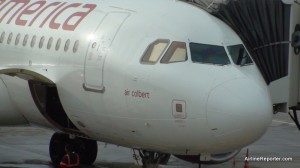
Virgin America Airbus A320 "Air Colbert," the aircraft I flew from SEA to SFO and back, sitting at SEA.
Spending most of a Saturday just flying to one airport then flying right back is not most people’s definition of “fun.” But for airline nerds like myself, it can be!
I fly a lot for personal and business reasons; however I have never been able to fly on Virgin America. Others in the aviation world, my friends, and my family have all given this airline and their in-flight entertainment system (called RED) positive reviews.
I decided I needed to experience RED first-hand. I talked with the fine folks at Virgin America and I was invited to take a flight from Seattle (SEA) to San Francisco (SFO) and back! Game on!
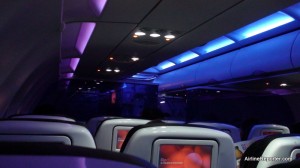
The lights really create a unique and pleasing atmosphere in the main cabin.
I would be flying on an Airbus A320 named “Air Colbert,” after the comedian “Stephen Colbert.” I was hoping this was a sign that it would be a fun ride.
The first thing you notice when getting onto a Virgin America plane is the awesome pink and purple lighting. My flight left around 1:45pm, when it was still light out, and the cabin lights were streaming pink and purple. On my flight back in the evening, the cabin was lit a lighter purple. I learned that they change the lighting as the day goes on to have less pink. I overheard the people in front of me say, “feels like we just got onto the party bus,” and I think that sums it up nicely. Virgin America doesn’t seem to install any special new lighting, they just replace the normal white bulbs with purple and pink. Why don’t more airlines do this?
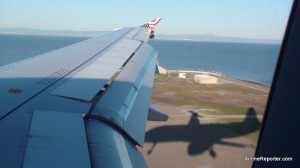
Taken when landing at SFO. I love landing at this airport, it is nothing but water until the last second before landing.
You are also welcomed by black leather seats, all with headrests and of course RED. On my flight to SFO, I purposely decided to sit in Row 13 (since I just wrote a blog on it the day before). Row 13 was lucky for me, since no one sat in the middle seat, even though the flight was quite full.
During the whole flight down to SFO, I played with RED. I have to say this is the most sophisticated in-flight entertainment system I have tried and should be something other airlines aspire to. There was free satellite TV, games (including Doom), chat, music (with 3000 mp3’s), and some internet movies. These alone would keep someone entertained for hours. However, there was also some premium content, like recently released movies, and recorded TV shows that one can purchase.
Virgin America has a standard drink cart service, however there are no free snacks. They make it easy to buy a snack, meal, or premium drink (a.k.a. one with alcohol) right on your RED screen. You can go through the menus, adding food and drinks to your cart (even free drinks), and then check-out. You can pay with your credit card via seat-back credit card swipe or the swipe in the RED remote. Then your order is sent back to a screen for the flight attendants to view, so they can fill and deliver your order. Ah yes, of course I had to test it out, and it worked wonderfully! Before I got my iPhone I would have considered the touch screen interface very high-tech, but I kept finding myself sliding my finger sideways to go to the next menu (like on an iPhone).
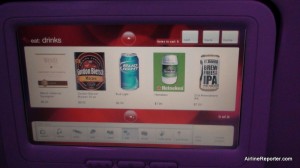
Ordering a drink or food is easy. Just push what you want on your screen, pay via your credit card at your seat, and someone will bring it to you.
Passengers have another option besides touching the screen. Every seat has a mini-remote, where one side lets you change channels, volume, go to the food menu, and on the other side you have a full QWERTY keyboard and video game remote control. You have the ability to chat one-on-one with someone in another seat (which is good if you are traveling with people you are not sitting next to) and you also have an overall chat room for the whole plane. I was very sad that no one came into the main chat room. Jaquelyn, the In-Flight Team Leader (who had an awesome accent) informed me that the chat function is very popular on flights to Vegas and when kids are flying in big groups. Luckily I was able to chat with a passenger one-on-one, who turned out to work for the airlines. I had a hard time working the mini-QWERTY keyboard with it being dark, but I think she got the jist of what I was saying.
If RED doesn’t entertain you enough, all their planes also have Wi-Fi and luckily for me, it was free and will be until January 15th. During the flight to SFO, the middle seat was empty and a laptop was easy to use, but on the flight back to SEA I had someone next to me, and being 6’1″ it isn’t easy to use a full sized laptop in my own little space. Under each seat there are USB and electrical plugs, so no need to worry about your device going dead mid-flight.
I am impressed with Virgin America’s level of service, the seat quality, and of course their in-flight system. Both my flights were about two hours, but they felt more like 30 minutes and I still don’t feel like I was even close to be bored with RED.
SEE MORE PICTURES OF MY ADVENTURE >>>
follow via | web | twitter | email | rss |
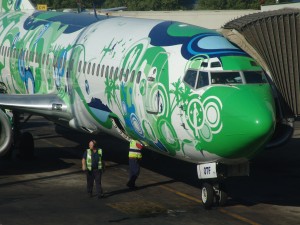
Kulula Air Boeing 737-400 with a very busy livery
Kulula Air is a low-cost airline based out of Johannesburg. The word “Kulula” is Zulu for light, easy, or simple. The airline was founded in 2001 and is owned by Comair, which is a franchisee of British Airways. They have a fleet of two Boeing 737-200’s and four Boeing 737-400’s. and they are known for their creative ads and odd liveries.
There is the very, very busy one in the photo and also a nice camouflage one as well.
Thanks AirlinesAngel for the tip!
follow via | web | twitter | email | rss |
Image: SouthAfrica.to
%CODE1%
What an amazing time in flight back then. Tex Johnson showed potential Boeing 707 customers what the plane was able to do. Without notice or warning to Boeing executives, Johnson did a barrel roll with his Boeing 707. The video shows the roll, but also has narrative from Johnson and shows a photograph taken from inside the aircraft while it was upside down. Could you imagine the test pilot of the Boeing 787 doing this on their first flight? Not likely.
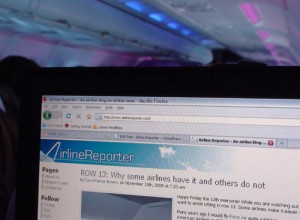
I only read the best stuff while on my flights. Taken just a few minutes ago.
I am currently posting this from 36,239 feet on a Virgin America flight from San Francisco (SFO) to Seattle (SEA). The in-seat map tells me we are over Central Oregon. Today I flew to San Fran and I’m now flying right back to Seattle to test out Virgin America’s in-flight entertainment system. I will post a full review of my experience on Monday, but while enjoying the Wi-Fi, I wanted to talk about it a little bit.
I am currently accessing the internet via GoGo and I don’t have to pay a dime. Virgin America, with Google, is offering free Wi-Fi on all their flights from now until January 15, 2010. Delta Air Lines, with eBay, is providing free Wi-Fi for a week starting November 24th.
The free internet is not only for folks on an airplane. Until January 15, 2010 Google will provide complimentary Wi-Fi in 47 airports across the country, including Las Vegas, Boston, Houston, Miami, and Seattle.
Seattle was supposed to be one of the 47 airports with free Wi-Fi. However, when I was there earlier today, I was excited to do some blogging while waiting for my flight to leave but it wasn’t free. Luckily I have an iPhone (airline and tech nerd) and found that there is a contract issue between AT&T (the current provider) and the airport.
Other airports got the Wi-Fi this Tuesday, but Seattle won’t be seeing it until November 18th. Every cloud has its silver lining; Seattle and Burbank airports will have free Wi-fi forever. I guess I will be ok with no Wi-Fi today for perpetually free Wi-Fi in a few days.
I am no stranger to technology and I fly quite a bit, but every time I have the access to the internet while flying, it feels magical. Some people say the magic of flying is gone but I disagree, it just depends on who you fly.
Internet is the future of airline travel. I feel that all airlines will have internet access in the near future. Once an airline cuts the Wi-Fi for landing, it is only a few minutes to re-connect on the 3G network and be connected once again. Awhile back, I talked about the possibility of having free Wi-Fi on airlines, but Andrew Compart with Things with Wings came up with another possible change that Wi-Fi could cause.
He caught something interesting in the Google media release about the free Wi-Fi, “A recent study conducted by the Wi-Fi Alliance reported that 50% of business travelers take red-eye flights in order to be “reachable” during business hours, and an overwhelming 82% said that being connected through Wi-Fi would help solve that problem.”
He brings up a good question that with business travelers having access to Wi-Fi during their flights, will fewer take red eye flights? Will that affect an airline’s business flying at night? I hope not. For personal travel, I enjoy red-eyes since I am able to sleep and I want as much vacation time as possible.
A year ago, there was barely any Wi-Fi on any flights. Hopefully a year from now Wi-Fi will be so common that there’s nothing left to even write about.. I think I am going to wrap up now, time to play Doom for the rest of the flight back home!
follow via | web | twitter | email | rss |






